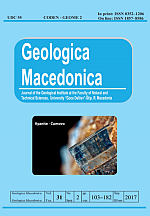PARAMETERS INFLUENCING DEVIATION OF RADON CONCENTRATION FROM ITS TYPICAL DIURNAL PATTERN IN THE WINTER AND SUMMER SEASONS
Abstract
Radon (222Rn) has been used as an atmospheric tracer for studying the vertical mixing processes in the planetary boundary layer (PBL). Therefore, the time series of hourly atmospheric radon concentration obtained in Ljubljana city were analyzed along with the meteorological data and back trajectory information from December 2016 to November 2017. Radon concentration exhibited the annual cycle with a higher mean in the winter (20.7 ± 15.5 Bq m–3) and a lower mean in the summer (14.6 ± 9 Bq m–3) reflecting the PBL evolution on a seasonal timescale. Most of the time, radon showed the typical diurnal variation following its related mean seasonal level attributed to the vertical mixing processes. Among this typical pattern, deviations of atmospheric radon concentration by more than ±σ from the related seasonal mean value have been detected in 9 events (±σ Ei) in the winter and summer seasons using simple statistical analysis. The parameter persistent/nocturnal inversion has usually been the reason for +σ Ei. While, the temporal variation of the exhalation rate, wind direction/speed and maritime air masses have been the responsible influencing parameter for –σ Ei.
Key words: atmospheric radon; continuous measurement; deviations in concentration; planetary boundary layer; persistent inversion; air masses




